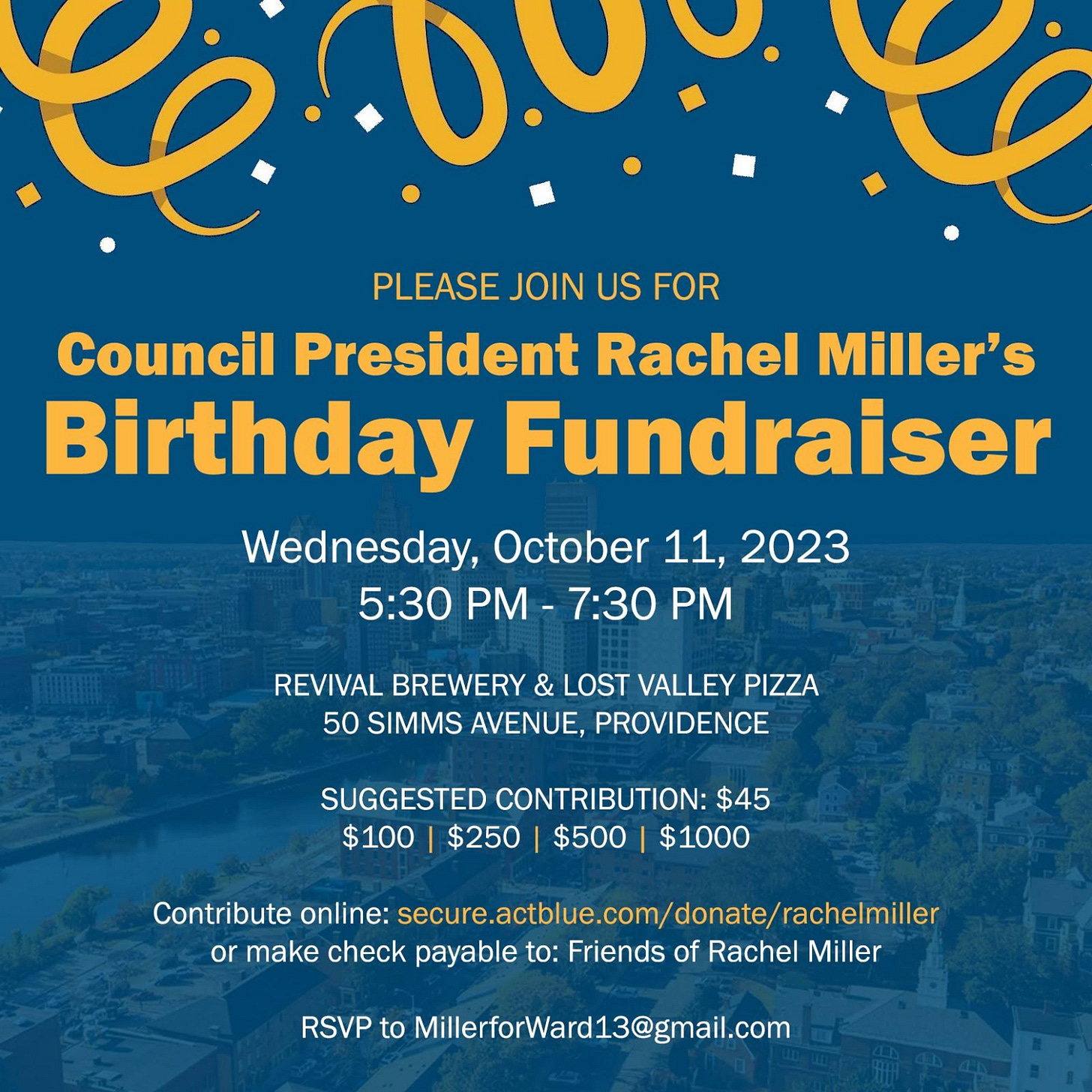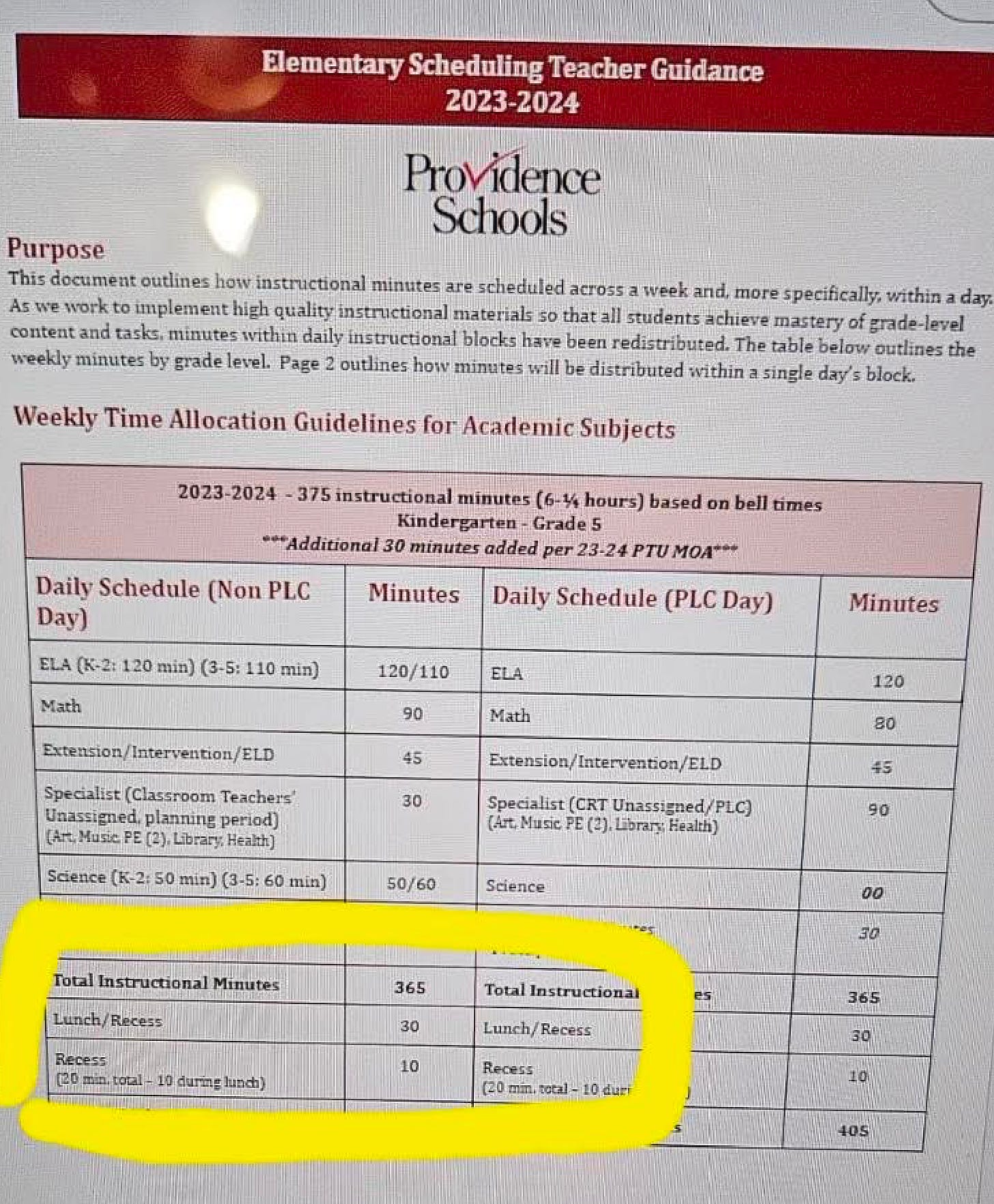Providence Public Elementary Schools violating law and best practices around recess
"Rhode Island state law requires that schools with elementary grades K-6 shall provide at least 20 consecutive minutes of supervised, safe, and unstructured free-play recess each day."
[Edit, September 28, 2023: “I want to clarify that one line that says students have 30 minutes for lunch and 10 minutes of recess because that isn't quite accurate,” said Paiva. “Students have 20 minutes of lunch (15 in line and 5 to eat) and 12-15 minutes of recess after transitions.”]
The American Academy of Pediatrics (AAP) has repeatedly stressed the role of recess “in promoting the optimal development of the whole child.” In a 2013 report in the Journal of Pediatrics, a team of researchers warned of a “growing trend toward reallocating time in school to accentuate the more academic subjects has put this important facet of a child’s school day at risk.”
In Providence Public Schools, this trend is now a reality, as the state takeover has led to the issuance of schoolday scheduling guidance that is in direct contravention of both state law and Providence School's Health and Wellness Policy.
Elementary school students, under a new policy that extends the school day by 30 minutes, receive 370 minutes in instructional time, 30 minutes for lunch, and 10 minutes of recess every day. There is nothing built into the schedule for transition time, that is, the time it takes to walk from the class to the lunchroom, time spent putting on cold weather clothing, or time spent in long lines waiting to be served lunch.
On September 20th Providence Schoolteacher Lindsay Paiva brought the issue to the attention of the Providence School Board. She was given only two minutes to make her case.
“In the name of equity I'm here to speak today,” said Paiva, who showed the board her schedule and reminded them of Rhode Island General Laws § 16-22-4.2 which clearly states that “All children attending public schools, or any other schools managed or controlled by the state, that have elementary grades kindergarten through six shall receive in those schools at least 20 consecutive minutes of supervised, safe, and unstructured free-play recess each day.”
“Unfortunately,” said Paiva, “This has not been the case for students in Providence Public Schools for at least the last three years. Despite the extended school day this year, students are still not provided 20 consecutive minutes of unstructured free play.”
"The kids are having a hard time getting through the longer day, so it's critically important they get the recess they deserve.”
I spoke to Lindsay Paiva by phone about her testimony.
“Elementary school schedules in Providence are based on the guidance provided by the district,” said Paiva. “Principals make the schedules but have to adhere to district guidance. In the scheduling guidance document,1 it's very clear that there are allotted times for each subject area. Elementary students don't switch classrooms, but we still have a schedule that we follow based on the guidance.
“For the past three years, the principals have been asked to combine lunch and recess so that there are 30 minutes allotted to what they call lunch slash recess. And there are an additional 10 minutes which is strictly recess. In the guidance document, it says 10 minutes of recess are happening during lunch so there is 20 minutes total. But the reality is that there's no transition time in the schedule at all for elementary and we have to move the kids from one place to another.
“Teachers are making the decisions about where the transition happens. Is the transition time coming out of their lunch or is the transition time coming out of the math instruction that comes before lunch? It takes a few minutes to walk from the classroom to the lunchroom.
“The other logistical issue is that the kids have to be moved from one place to the other. We only have one cafeteria. We have three lunches and there's no transition time built in, which means a hundred kids are coming into the cafeteria and a hundred kids are leaving the cafeteria through one hallway at the same time every day. It takes five minutes. We're a three-story school.
“So we lose time there in that transition. When the weather is bad, we bring them back to the classroom for recess. And even when it's good weather, we still have to transition them from the cafeteria to outside. The sticking point that's been tricky logistically is that because the teacher's contract says that we get a 30-minute lunch and we supervise recess, we cannot supervise those first 10 minutes of recess that are coming out of lunch because we're still on our contractual lunchtime. What is happening is we have to go pick the students up from wherever they are and then continue the recess. That means there's a handoff from the lunch supervisors who have, again, zero transition time to get back into lunch to supervise the next group and hand off to us to supervise the students' remaining 10 minutes.
“The reality is that there are a couple of pieces of the law and the health and wellness policy that are being violated,” continued Paiva. “Under the law, it's very clear that students must be seated and eating for 20 minutes. It's also very clear in the Providence Health and Wellness Policy, but it's obviously logistically impossible that if I drop my class off at 12:30, they're going to be eating food starting at 12:30.”
In Providence School's Health and Wellness Policy, written to be in accordance with State Law, it is specified that "Schools shall schedule lunch periods at appropriate times and provide students with at least 20 minutes to eat after being served and seated."
The policy also contains the following:
"Exercise and fresh air [are] an important part of the school day, and play has a positive effect on student academic achievement and social development. Rhode Island state law requires that schools with elementary grades K-6 shall provide at least 20 consecutive minutes of supervised, safe, and unstructured free-play recess each day."
Note: The above is a paid advertisement. Every penny made is poured back into my reporting. Let me know your thoughts about such advertisements in the comments!
Lindsay Paiva: Every single kid has to go through the line. They have a lanyard and they have to get their tray and then go sit down. Our kids are very well-behaved and compliant, but to move a hundred kids through a line does not take zero minutes. So they're not sitting for 20 minutes because they have to line up, they have to clean up their table, line up again to go outside or in the winter or during inclement weather, back to the classroom.
Steve Ahlquist: And there's going to be coats to put on and gloves and boots or whatever.
Lindsay Paiva: Totally. If it's freezing cold, they usually bring all their stuff to the cafeteria and they go outside. It's tricky if we go back to the classrooms because there aren't enough lunch supervisors for each classroom to have a supervisor during inclement weather. There are only three or four lunch supervisors max, and there are usually four to five classrooms per lunch in my school. And we have a small school.
Steve Ahlquist: So what we're essentially saying is that there's a state-mandated amount of time that these children should be given to recess, just free time to run around and be kids. And that time is not being allocated properly. Some of that time is being merged with lunch, where they're not really running around being kids, they're going through a line and getting their lunch, sitting down, and eating for whatever amount of time that takes.
Lindsay Paiva: Right. What's happening is they're spending most of their lunch in line.
The reality is that many principals are flexible. What we used to do was they would have 30 minutes for lunch, and then we would pick the students up from the lunchroom and take them for 20 minutes of recess. That's fine, but that's not on the schedule. If teachers are not in a setting with a flexible principal, or if they're untenured and then caught violating a directive or not following the mandated schedule, they can get into trouble for that. It needs to be codified in the schedule.
RIDE pushes back
Lindsay Paiva: After I testified at the School Board meeting, we lost our flexibility and they doubled down on the directive. What happened after that is that kids went through the lunch line, sat down, and at the 20-minute mark, they were asked to clear their places and go outside for recess. But some kids had just sat down to eat. If you were the last in line, you probably sat down at the 15-minute mark. So now we're throwing away food. Kids are not having adequate time to eat. It's not tenable.
This is making me worried because now students are not being given enough time to eat. And the law says that recess minutes have to be consecutive. There has to be 20 uninterrupted minutes of recess. Transitioning from the cafeteria up to the classroom when it's cold weather, that's not recess. Those transition minutes should not be counted as recess.
Equity
Lindsay Paiva: For me, this is an equity issue because of the disparities across districts. Most kids in other districts get at least 20 minutes, but many get 25. I know, for example, Coventry has two recesses for elementary. There's one attached to lunch that's 20 minutes and there's also a morning or an afternoon one depending on when your special period is.
Steve Ahlquist: Is the district doing this because they're trying to increase academic performance at the expense of recess?
Lindsay Paiva: Maybe. But it's not research-based and it's not best practice. Taking recess out of lunch is not only illogical it's literally impossible in most schools. If you've ever lined up eight-year-olds you know what's up. That doesn't happen in zero minutes...
Steve Ahlquist: If I couldn't take breaks while I was doing my work during the day, I would lose it. If I had to sit in my chair and just write for four hours, I wouldn't do it. I couldn't do it.
Lindsay Paiva: It's not sustainable. The students need excellent instruction and they need wraparound support. We're not meeting their social-emotional needs. My kids are hungry. The day is long, they're tired, and they fall asleep at three o'clock.
Steve Ahlquist: So how do we fix this?
Lindsay Paiva: I was thinking that there needed to be a policy passed, and then I did some digging and I found Providence School's Health and Wellness Policy. So it's already passed. I don't understand how the district can create and ignore state guidance. Our district is run by the state.
Steve Ahlquist: So the District is promulgating policies in contravention of state law, and policies the district has previously passed.
Lindsay Paiva: I was thinking that maybe I could advocate for a policy that takes state law and makes it Providence-specific, just to cover all the bases, because state law should be enough. Then I saw that there already is such a policy, and they are creating and distributing guidance that is a direct contradiction to a policy that's already been passed and functioning.
The fix, to me, is the schedules have to change. We're being asked to break the law every day, and it's putting everyone in a difficult position.
The Rhode Island Department of Education did not respond to a request for comment in time for publication.





Kids need a real recess. It is the cheapest thing they can do, needs no instructional materials. They learn better if they have recess. Eat healthier. Do not steal childhood.